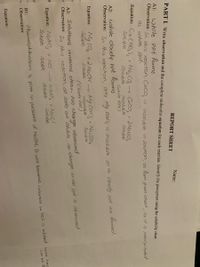
Chemistry
10th Edition
ISBN: 9781305957404
Author: Steven S. Zumdahl, Susan A. Zumdahl, Donald J. DeCoste
Publisher: Cengage Learning
expand_more
expand_more
format_list_bulleted
Question
I need help with my homework

Transcribed Image Text:Certainly! Here's a transcription and explanation of the document as it might appear on an educational website:
---
**Chemistry Lab Report Sheet**
**PART I: Write observations and complete molecular equations for each reaction. Identify the precipitant using the solubility chart.**
**A1:**
- **Observation:** White ppt forms.
- **Explanation:** In this reaction, \( \text{CaCO}_3 \) is insoluble in solution as per the given chart, so it is precipitated as white ppt.
- **Equation:** \( \text{Ca(NO}_3)_2 + \text{Na}_2\text{CO}_3 \rightarrow \text{CaCO}_3(s) + 2\text{NaNO}_3 \)
**A2:**
- **Observation:** White cloudy ppt forms.
- **Explanation:** In this reaction, only \( \text{Mg(OH)}_2 \) is insoluble so its cloudy ppts are formed.
- **Equation:** \( \text{MgSO}_4 + 2\text{NaOH} \rightarrow \text{Mg(OH)}_2(s) + \text{Na}_2\text{SO}_4 \)
**A3:**
- **Observation:** Solution remains clear.
- **Explanation:** In this reaction, all salts are soluble hence no change or no ppt is observed.
- **Equation:** \( \text{NaNO}_3 + \text{KCl} \rightarrow \text{KNO}_3 + \text{NaCl} \)
**B1:**
- **Observation:** Phenolphthalein is pink in presence of NaOH. It will become colorless as HCl is added.
- **Explanation:** Phenolphthalein is a pH indicator that turns pink in basic solutions and colorless in acidic solutions.
---
This transcription provides a logical flow and explanation for each reaction based on the solubility of the compounds involved, useful for educational purposes.

Transcribed Image Text:In Part I (A) reactions, how did you decide what (compound) precipitated?
Expert Solution
arrow_forward
Step 1
In each of the cases in Part I (A), the precipitated compound is predicted.
Trending nowThis is a popular solution!
Step by stepSolved in 3 steps

Knowledge Booster
Learn more about
Need a deep-dive on the concept behind this application? Look no further. Learn more about this topic, chemistry and related others by exploring similar questions and additional content below.Similar questions
- The recommended daily allowance (RDA) of a certain amino acid is 15 mg per kg of weight. How many grams per day should a 60 kg person consume? Group of answer choices 900 g 0.9 g 0.25 g 4 garrow_forwardA dose of aspirin of 5.0 mg per kilogram of body weight has been prescribed to reduce fever in an infant weighing 8.5 pounds. The number of milligrams of aspirin that should be administered is 19 mg 5.0 mg 0.59 mg 53 mg 1.6 mgarrow_forwardhelp me solve this pleasearrow_forward
- An IV pump delivers medication at a contstant rate of 24mg/hr. How long does it take to deliver 90mgarrow_forwardA patient provides a urine sample. The density of the patient's urine is 1.0212 g/mL. What is the specific gravity of the urine? specific gravity:arrow_forwardAssume the recommended single dose of ibuprofen for children over the age of two is 4.5 mg per pound (mg/lb) of body weight. Use this guideline to calculate a single dose in milligrams for a five-year-old child who weighs 47 lb. dosage: mgarrow_forward
- After analyzing soil samples, we found 70 mg arsenic in 120 kg soil. Concentration of arsenic in the soil = ________ ppmmarrow_forwardAccording to the chemical handbook of the lab activity the density of rhodium would be: Question 1 options: 7 g/ml 15 g/ml 12.4 g/cm3 22 g/cm3arrow_forwardCefuroxime is to be administered 20mg per Kg IV Q4H. How many mg per dose should a child weighing 36 pounds receive?arrow_forward
arrow_back_ios
arrow_forward_ios
Recommended textbooks for you
 ChemistryChemistryISBN:9781305957404Author:Steven S. Zumdahl, Susan A. Zumdahl, Donald J. DeCostePublisher:Cengage Learning
ChemistryChemistryISBN:9781305957404Author:Steven S. Zumdahl, Susan A. Zumdahl, Donald J. DeCostePublisher:Cengage Learning ChemistryChemistryISBN:9781259911156Author:Raymond Chang Dr., Jason Overby ProfessorPublisher:McGraw-Hill Education
ChemistryChemistryISBN:9781259911156Author:Raymond Chang Dr., Jason Overby ProfessorPublisher:McGraw-Hill Education Principles of Instrumental AnalysisChemistryISBN:9781305577213Author:Douglas A. Skoog, F. James Holler, Stanley R. CrouchPublisher:Cengage Learning
Principles of Instrumental AnalysisChemistryISBN:9781305577213Author:Douglas A. Skoog, F. James Holler, Stanley R. CrouchPublisher:Cengage Learning Organic ChemistryChemistryISBN:9780078021558Author:Janice Gorzynski Smith Dr.Publisher:McGraw-Hill Education
Organic ChemistryChemistryISBN:9780078021558Author:Janice Gorzynski Smith Dr.Publisher:McGraw-Hill Education Chemistry: Principles and ReactionsChemistryISBN:9781305079373Author:William L. Masterton, Cecile N. HurleyPublisher:Cengage Learning
Chemistry: Principles and ReactionsChemistryISBN:9781305079373Author:William L. Masterton, Cecile N. HurleyPublisher:Cengage Learning Elementary Principles of Chemical Processes, Bind...ChemistryISBN:9781118431221Author:Richard M. Felder, Ronald W. Rousseau, Lisa G. BullardPublisher:WILEY
Elementary Principles of Chemical Processes, Bind...ChemistryISBN:9781118431221Author:Richard M. Felder, Ronald W. Rousseau, Lisa G. BullardPublisher:WILEY

Chemistry
Chemistry
ISBN:9781305957404
Author:Steven S. Zumdahl, Susan A. Zumdahl, Donald J. DeCoste
Publisher:Cengage Learning

Chemistry
Chemistry
ISBN:9781259911156
Author:Raymond Chang Dr., Jason Overby Professor
Publisher:McGraw-Hill Education

Principles of Instrumental Analysis
Chemistry
ISBN:9781305577213
Author:Douglas A. Skoog, F. James Holler, Stanley R. Crouch
Publisher:Cengage Learning

Organic Chemistry
Chemistry
ISBN:9780078021558
Author:Janice Gorzynski Smith Dr.
Publisher:McGraw-Hill Education

Chemistry: Principles and Reactions
Chemistry
ISBN:9781305079373
Author:William L. Masterton, Cecile N. Hurley
Publisher:Cengage Learning

Elementary Principles of Chemical Processes, Bind...
Chemistry
ISBN:9781118431221
Author:Richard M. Felder, Ronald W. Rousseau, Lisa G. Bullard
Publisher:WILEY